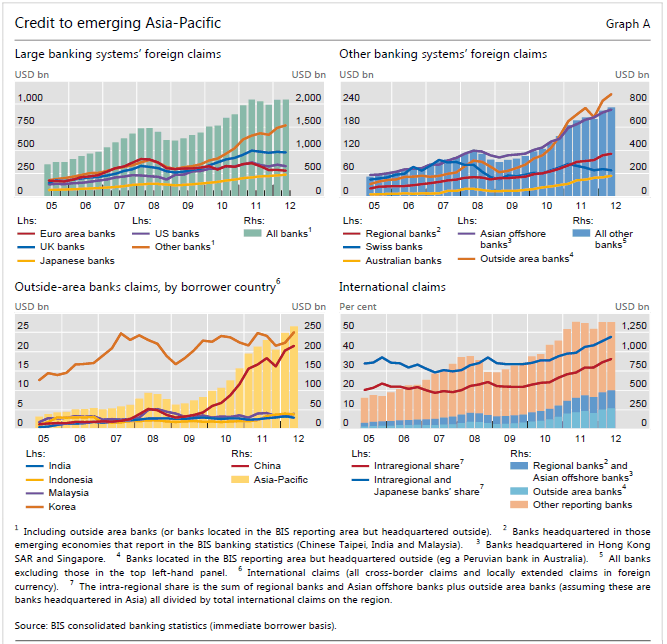Shifting credit patterns in emerging Asia
(Extract from pages 17-18 of BIS Quarterly Review, December 2012)
Unlike in other emerging market regions, international credit to borrowers in Asia-Pacific1 held up relatively well in the aftermath of the crisis. This occurred despite the pullback by some European banks, mostly from the euro area and Switzerland, which have adjusted their balance sheets in response to the global financial crisis and the more recent stresses in the euro area sovereign debt market (see the special feature by Avdjiev et al in this issue). Total foreign claims on the Asia-Pacific region grew by $613 billion, or 41%, between mid-2008, just before the collapse of Lehman Brothers, and the second quarter of 2012 to stand at $2.1 trillion (Graph A, top left-hand panel). The growth in claims there stands in sharp contrast to developments in other emerging regions. Claims on Latin America rose by a more modest $254 billion (24%) during the same period, while claims on emerging Europe fell by $230 billion (14%).
The expansion in international credit to Asia-Pacific has gone hand in hand with significant changes in the composition of creditor banks in the region. US and UK banks' claims started to grow again from early 2009 onwards, but have levelled off since mid-2011 (Graph A, top left-hand panel, purple and blue lines). For their part, euro area banks on aggregate shrank their positions by around $120 billion (or an estimated 30%) between mid-2008 and mid-2012 (red line).2 In contrast, Japanese banks (yellow line) expanded their foreign claims on the region by an estimated $100 billion. And, even more significantly, other banks (brown line) expanded strongly vis-à-vis the region: their claims grew from $369 billion in mid-2008 to $770 billion by mid-2012. Overall, UK, US and Japanese banks' shares of total foreign claims on the region have remained relatively stable since the start of the global financial crisis in 2008 (around 23%, 16% and 11%, respectively), while the share of euro area banks declined sharply, from 27% in mid-2008 to 13% in mid-2012. This reduction was mirrored by a rise in the share of banks from other countries (27% to 37%).
Incomplete data make it difficult to identify the nationality of these other banks (Graph A, top right-hand panel). The BIS consolidated statistics show that banks headquartered in Asian offshore centres (Hong Kong SAR and Singapore) expanded their foreign claims on Asia-Pacific, from $119 billion in mid-2008 to $225 billion in mid-2012 (purple line). And banks headquartered in those emerging Asian countries that report in these statistics (Chinese Taipei, India and Malaysia) doubled their intraregional foreign claims during the same period, to $111 billion (red line). For their part, Australian banks' claims on the region have risen almost threefold since mid-2008, to $54 billion (yellow line).
But the consolidated statistics also indicate rapid growth in cross-border credit provided by banks that are not headquartered in one of the BIS reporting countries (brown line).3 While the nationality of these "outside area" banks is not known, it is likely that banks headquartered in the region account for the bulk of these other claims, as explained below.4 In total, outside area banks' international claims on emerging Asia-Pacific rose to $265 billion by mid-2012 (Graph A, top right-hand panel), primarily to borrowers in China (bottom left-hand panel). Moreover, the data also indicate that these creditor outside area banks were primarily located in Asia; the offices of outside area banks not located in Asia (excluding Japan) accounted for a mere $85 billion (32%) compared to a relatively large $180 billion booked by such banks located in Asian offshore centres.
Evidence marshalled from other sources sheds more light on the identity of these outside area banks. Data from Bankscope, for example, show that the (unconsolidated) total assets of Chinese banks' foreign offices in Asia (excluding Singapore) grew by $135 billion (74%) from 2007 to 2011, consistent with the rapid growth in outside area banks' international claims on emerging Asia-Pacific during the same period (Graph A, bottom lefthand panel).5 In addition, Asian banks (including Hong Kong and Singapore banks, but excluding Japanese banks) accounted for a growing share of total syndicated lending to emerging Asia-Pacific. New signings, as reported by Dealogic, show a marked uptick in participation by Asian banks: their new syndicated loans topped $223 billion in 2011, up by 80% from 2007. As a result, Asian banks' share of total signings to Asia-Pacific increased from 53% to 64%.
Combined, the rise of intraregional lending and the growth in positions from smaller banking systems have filled the gap left by euro area and Swiss banks (Graph A, bottom right-hand panel). Euro area and Swiss banks' claims fell from 38% of total international claims on Asia-Pacific in mid-2008 to 19% in mid-2012. In contrast, estimated intraregional lending, which includes the claims of reporting Asian banks (ie banks headquartered in Chinese Taipei, Hong Kong SAR, Malaysia, Singapore and India) on borrowers in the region, plus the claims of outside area foreign banks (under the assumption that they are Asian banks) on these same borrowers, accounted for a combined 36% of total international claims on the region in mid-2012, up from 22% a few years earlier (brown line). If the positions of Japanese banks are added to intraregional credit, the share of international credit provided by these banks to Asia-Pacific grew from 33% to 48% (blue line).
1 Following the classification of the BIS international banking statistics, the emerging Asia-Pacific region does not include Hong Kong SAR, Macao SAR and Singapore, which are classified as Asian offshore financial centres.
2 When estimated exchange rate adjustments are taken into account, the fall of euro area banks' foreign claims on emerging Asia-Pacific countries is around the same (27%).
3 In the BIS consolidated banking statistics (immediate borrower basis), reporting central banks provide data to the BIS on the worldwide consolidated positions of banks headquartered in the respective country, and information on the cross-border positions of the offices of banks located in the country which have a parent institution from a non-BIS reporting country. An example of the latter would be the cross-border positions of the offices of a Peruvian bank in Australia: Peru is a non-reporter, and thus Peruvian banks' global consolidated positions are not picked up, but Australia provides the cross-border positions of the offices of Peruvian banks in Australia. This information helps the BIS to better track global lending and the extent to which banks from non-reporting countries account for cross-border credit. Unfortunately, no information about the nationality of these so-called "outside area" foreign offices is available.
4 Figures for foreign claims of outside area foreign banks in the top right-hand panel of Graph A are actually those for international claims, as data on local currency claims of these banks on residents in the region are not available.
5 This includes Chinese banks in Hong Kong SAR, India, Macao SAR, Malaysia and Thailand, although their operations are highly concentrated in Hong Kong. According to Bankscope, Chinese banks' unconsolidated total assets booked by their subsidiaries in Hong Kong increased by around $120 billion from 2007 to 2011, to $295 billion.



